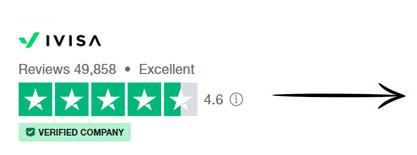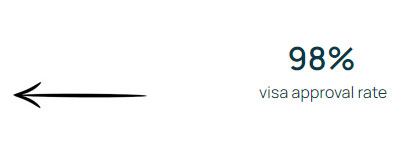Do I need an eTa or eVisitor for Australia?
eVisitor or eTA for Australia? Find the visa that's right for you, depending on your nationality, the length of your stay and the purpose of your trip.
 Fast: Simplified, efficient process.
Fast: Simplified, efficient process.
 Security: information is protected.
Security: information is protected.
 Reliability: 98% approval rate.
Reliability: 98% approval rate.
 Assistance: 24/7 customer support.
Assistance: 24/7 customer support.


Travelling to Australia means choosing the right visa, and for many travellers the most common options are the eVisitor and the eTA (Electronic Travel Authority). These two visas allow you to visit Australia for short stays, whether for tourism, business or visiting relatives. Although they appear similar, there are some key differences between the eVisitor and the eTA, particularly in terms of the nationalities eligible, the conditions for obtaining them and the associated fees.
eTA and eVisitor differences for Australia: in brief
- Eligible nationalities: The eVisitor is intended for citizens of the European Union and certain European countries, while the eTA is designed for citizens of countries such as the United States, Canada and Japan.
- Cost: The eVisitor is generally free of charge, excluding any processing fees, while the eTA incurs a government fee of around AUD 20.
- Application process: The eVisitor and eTA can be applied for online via the Australian government's official website or can be applied for online by a private service provider.
- Length of stay: Both visas allow a maximum stay of 3 months per visit, but are valid for multiple entries for 12 months.
- Use: Both the eVisitor and the eTA are designed for unpaid tourist or business travel, but do not allow work in Australia.


The eVisitor is an electronic visa for citizens of the European Union and certain other European countries who wish to visit Australia for short stays.
This visa allows travellers to enter Australia for tourism, business or to visit friends and family. The eVisitor is easy to obtain, as the application is made online, and once approved, it is electronically linked to your passport, eliminating the need to have a physical visa sticker in your passport.
The eVisitor is specifically designed for citizens of the European Union and other European countries. Here are some examples of nationalities eligible for the eVisitor:
To obtain an eVisitor, you must meet certain conditions:
The eVisitor is mainly used for :
The eTA (Electronic Travel Authority) is an electronic travel authorisation for citizens of certain countries who wish to visit Australia for short stays. The eTA allows multiple entry into Australia for tourism or business purposes, while offering a simplified procedure. Unlike a traditional visa, the eTA does not require a paper application or a visit to the embassy. Once approved, the eTA is electronically linked to the traveller's passport, facilitating access to Australia without the need for a physical visa.
The eTA is available to citizens of certain countries, including :
These nationalities can apply for an eTA online or via a mobile application, and this quick and practical process makes it possible to prepare for a trip to Australia without major administrative complications.
The conditions for obtaining and the main uses of the eTA are the same as for the eVisitor.
To help you understand the main differences between the eVisitor and the eTA for Australia, we have summarised the key information in the comparison brief below. This brief compares the two types of visa in terms of eligible nationalities, the application process, associated fees, length of validity and conditions of stay, as well as the number of entries allowed.
Choosing between eVisitor and eTA depends mainly on your nationality, the length of your stay in Australia and the purpose of your trip.
The first step in choosing between the eVisitor and the eTA is to check whether your nationality is eligible for either visa. If you are a citizen of a European country, the eVisitor is probably the best option for you, as it is generally free and designed specifically for citizens of the European Union and other European countries. If you are a citizen of the United States, Canada, Japan or other eligible Asian countries, the eTA will be your default choice.
To help you understand which visa to choose according to your situation, here are some typical scenarios:
Scenario 1: French tourist planning a trip to Australia
Jean, a French citizen, is planning to visit Australia for three weeks to discover Sydney, the Great Barrier Reef and Uluru National Park. As a citizen of the European Union, Jean is eligible for the eVisitor. This visa is free (excluding any processing fees) and allows him to stay in Australia for up to 3 months, which is perfect for his trip. Jean therefore opts for the eVisitor.
Scenario 2: American businessman travelling to Australia
Mike, an American citizen, has to travel to Australia for a series of business meetings in Melbourne and Sydney. Being eligible for the eTA, Mike decides to apply via the official mobile application. Although the eTA costs AUD 20, he appreciates the simplicity of the online process and the ability to enter and leave Australia as many times as necessary throughout the year, which is perfect for his frequent travels.
Scenario 3: Japanese tourist planning several trips to Australia
Akiko, a Japanese citizen, plans to visit Australia twice in the coming year: once for a summer holiday in Sydney and once for a wedding in Melbourne. She opted for the eTA, which allows her to enter Australia several times over a 12-month period, with each stay lasting up to 3 months. The eTA is the ideal solution for Akiko because she can plan her trips with complete peace of mind.
Find out if your question has been answered in the list below
Eligibility for eVisitor or eTA depends on your nationality. eVisitor is reserved for citizens of the European Union and certain other European countries. If you are a citizen of a country such as France, Germany or Italy, eVisitor is probably the right choice for you. The eTA, on the other hand, is available to citizens of countries such as the United States, Canada, Japan and Singapore. To confirm your eligibility, you can consult the list of eligible nationalities on the Australian government's official website.
Neither the eVisitor nor the eTA allows you to work in Australia. These visas are designed for tourist stays, family visits or unpaid business trips. If you plan to work in Australia, even temporarily, you will need to apply for a specific work visa, such as the Working Holiday Visa or Temporary Skill Shortage Visa, depending on your situation.
It is recommended that you apply for your eVisitor or eTA at least a few weeks before your planned departure for Australia. Although the application process is quick, it is wise to leave enough time in case of delays or if additional information is required. e-Visas are usually approved within a few days, but early planning will ensure your trip goes smoothly.